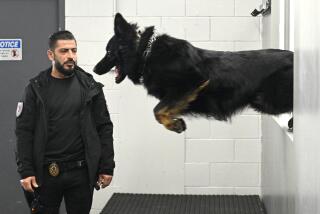Protection for a Marine’s Best Friend
- Share via
WASHINGTON — When Marines head for war zones overseas, they’re outfitted with the latest in protective gear. Now their K-9 units are being similarly equipped.
Since December, all military dogs deployed to Iraq and Afghanistan have been issued state-of-the-art Kevlar vests, which cover the animal’s body from the shoulders to hindquarters, protecting the heart, lungs and stomach from knife attacks, bullets and shrapnel. The vests weigh about 7 pounds and cost $550 to $1,200 apiece.
Providing dogs with body armor is “a priority because they’re hard to replace,” said Marine Sgt. Nestor G. Antoine, kennel master at the Marine Corps Logistics Base in Albany, Ga., one of several bases housing K-9 units.
The Marines’ K-9 units in Iraq and Afghanistan are used for sentry duty and detecting explosives. Although no dogs have been killed in Iraq, some have been injured, prompting the decision to provide the vests, said Bill Childress, coordinator of the Marine Corps’ Working Dog Program, based at the Pentagon.
Some stateside Marine K-9 units also have been issued the armor for their work guarding base entrances and civilian airports and accompanying Secret Service missions, Antoine said.
Childress declined to disclose how many dogs are in Iraq and Afghanistan but said the corps has obtained more than 150 vests for its K-9 units worldwide.
Although the vests may seem expensive, they are worth it, Antoine said, because they help protect dogs that play a crucial role in the military and that are expensive to train. It costs more than $40,000 to breed and train a drug-sniffing dog, he said, and the cost for a dog trained to search out explosives can reach $60,000. All military dogs are trained at the Department of Defense Military Working Dog School at Lackland Air Force Base in Texas.
“With the war on terrorism, we have to take extra precaution not to lose them,” Antoine said of the dogs.
The body armor includes pouches for cooling packs to help dogs cope with high temperatures; the average high in Baghdad in July 2003, for instance, was 110 degrees. The vests also are equipped with rappel loops and a harness should the animals need to scale a steep slope or be deployed via parachute.
Although the vests are designed to save dogs’ lives, the weight of the body armor can become a hindrance.
“Seven pounds to a dog is like 20 for a human,” Antoine said. The vests limit dogs’ ability to run and jump, and slow their reaction time, he said.
The Marines use several breeds, including German shepherds and Belgian Malinois, for detecting mines and explosives. The dogs also sniff out drugs at border crossings and in barracks, said Cpl. Michael Heiderscheit, who is stationed at the Marine Corps Logistics Base.
Officials from the CIA and the Secret Service declined to say whether their canine units are protected by body armor. FBI dogs used for tracking weapons, explosives and drugs are not fitted with vests.
The Navy has no policy on the body armor, said Lt. Jon Spiers. However, units and individual dog handlers may request protection for their animals. Army dogs used overseas in detecting mines and explosives also wear bulletproof gear, but animals in homeland operations do not. The Air Force does not outfit its dogs in body armor but is considering doing so, said Gary Emery, chief of public affairs at Lackland Air Force Base.
Police departments in Los Angeles, Miami, New York, Chicago and Washington began outfitting their dogs with vests several years ago. LAPD dogs have been issued vests since 2001.
More to Read
Sign up for Essential California
The most important California stories and recommendations in your inbox every morning.
You may occasionally receive promotional content from the Los Angeles Times.













